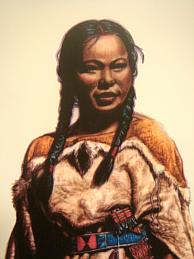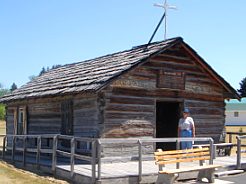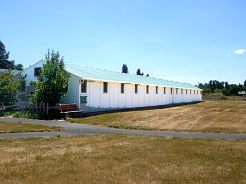Ft. Missoula
Living Historic Museum
Missoula, MT
August 2nd, 2006
 As
we drove through Montana one early morning, we passed through Missoula. We
had been here before and were not intending to look further for something
interesting to write about. Laura, however had found something that was of
interest. Old Fort Missoula, just out of town to the southwest. We
decided to ride out that way and see if there was anything there that we could
make a story about. I'm glad we did. We found that the Fort area has
had a distinguished and varied history, ending with its takeover by the
Historical Museum of Missoula in 1975. We parked in front of the
Quartermaster's store, which now serves as the Museum entrance and store.
We decided to take the self-guided tour. From a large sign at the front of
the store we learned that the first troops arrived on June 25, 1877. A
month later, troops and civilian volunteers failed to delay Chief
Joseph of the Nez Perce in his passage North. Shortly thereafter, the
first action seen was under Col. Gibbon at the battle of the Big Hole
where 13 were killed and 14 wounded. That ended, for the most part,
all combat seen in or around the Fort. The Fort went on as a defensive
quarterstone
for Western Montana, building roads, erecting telegraph lines and escorting
Indians. In 1888 the Fort saw the arrival of a new kind of soldier.
The 25th Infantry Bicycle Corps arrived. It stayed for 10 years but the
bicycle was found to be less than effective under war conditions and the
experiment was ended. The Fort went on to see use as an Alien detention
camp, and for a
As
we drove through Montana one early morning, we passed through Missoula. We
had been here before and were not intending to look further for something
interesting to write about. Laura, however had found something that was of
interest. Old Fort Missoula, just out of town to the southwest. We
decided to ride out that way and see if there was anything there that we could
make a story about. I'm glad we did. We found that the Fort area has
had a distinguished and varied history, ending with its takeover by the
Historical Museum of Missoula in 1975. We parked in front of the
Quartermaster's store, which now serves as the Museum entrance and store.
We decided to take the self-guided tour. From a large sign at the front of
the store we learned that the first troops arrived on June 25, 1877. A
month later, troops and civilian volunteers failed to delay Chief
Joseph of the Nez Perce in his passage North. Shortly thereafter, the
first action seen was under Col. Gibbon at the battle of the Big Hole
where 13 were killed and 14 wounded. That ended, for the most part,
all combat seen in or around the Fort. The Fort went on as a defensive
quarterstone
for Western Montana, building roads, erecting telegraph lines and escorting
Indians. In 1888 the Fort saw the arrival of a new kind of soldier.
The 25th Infantry Bicycle Corps arrived. It stayed for 10 years but the
bicycle was found to be less than effective under war conditions and the
experiment was ended. The Fort went on to see use as an Alien detention
camp, and for a while a POW camp for Italian prisoners. It still sees an occasional
professional soldier on its parade field. Both the Montana Reserve and
the Montana National Guard use the land. The static displays inside the
small museum told the story of early Montana. Back in 1803, Thomas
Jefferson, then President, and visionary, saw the U.S. being hemmed in by other
countries. He was determined to expand the U.S. territories as far west as
he could. Jefferson secured approval for an expedition westward to map and
claim as much land as possible. He chose a man named Meriwether Lewis to
head up the expedition. Jefferson felt strongly that the mission was so
important, that he made
sure that Lewis was trained to undertake scientific investigations, and that he had
the best equipment for measurements and the latest maps, along with the necessary
references books. Jefferson sent Lewis to Philadelphia to receive
instructions from
five scholars who would
while a POW camp for Italian prisoners. It still sees an occasional
professional soldier on its parade field. Both the Montana Reserve and
the Montana National Guard use the land. The static displays inside the
small museum told the story of early Montana. Back in 1803, Thomas
Jefferson, then President, and visionary, saw the U.S. being hemmed in by other
countries. He was determined to expand the U.S. territories as far west as
he could. Jefferson secured approval for an expedition westward to map and
claim as much land as possible. He chose a man named Meriwether Lewis to
head up the expedition. Jefferson felt strongly that the mission was so
important, that he made
sure that Lewis was trained to undertake scientific investigations, and that he had
the best equipment for measurements and the latest maps, along with the necessary
references books. Jefferson sent Lewis to Philadelphia to receive
instructions from
five scholars who would  round
out his knowledge in mapping methods. During this time Lewis learned how to use
a chronometer, and how to take observations with it. This required Lewis
to adapt standard methods of measurements for use in the wilderness, including
the making of an artificial horizon when the sun was not available. Lewis asked
William Clark, an old frontiersman and Indian fighter to join him and the Lewis
and Clark Expedition was created. One of the most remembered people on the
trip was Sacagawea, a 17 year old Shoshone girl who's husband, a French fur
trapper named Charbonneau, served as a translator. She joined the group at
Fort Mandan, near present day Washburn, North Dakota. After the expedition, she was invited
by Lewis to live in Saint Louis where she stayed until she died of the fever in
1825. A likeness of her can be found on the U.S. gold dollar by the same
name. There were many
round
out his knowledge in mapping methods. During this time Lewis learned how to use
a chronometer, and how to take observations with it. This required Lewis
to adapt standard methods of measurements for use in the wilderness, including
the making of an artificial horizon when the sun was not available. Lewis asked
William Clark, an old frontiersman and Indian fighter to join him and the Lewis
and Clark Expedition was created. One of the most remembered people on the
trip was Sacagawea, a 17 year old Shoshone girl who's husband, a French fur
trapper named Charbonneau, served as a translator. She joined the group at
Fort Mandan, near present day Washburn, North Dakota. After the expedition, she was invited
by Lewis to live in Saint Louis where she stayed until she died of the fever in
1825. A likeness of her can be found on the U.S. gold dollar by the same
name. There were many  other
things of interest in the museum but the day was passing and it was time to see
the outside. There are three original buildings on the property. One
that was of interest to me was the old St. Michael's church. According to the
handout provided by the museum store, the church served the area's settlers. In
1873 a government survey disclosed that the Jesuits and a local farmer both claimed the same 40 acres of land,
so the church was moved by wagon to Missoula. It stood on the grounds of St. Patrick Hospital for many years before it was returned to the site of old Hell Gate in 1962. The Friends of the Historical
Museum at Fort Missoula moved the church to the museum grounds. Further
out to the east, we arrived at the barracks used for Italian POWs during WWII.
The handout advised that Alien Detention Center Barracks, which were built in 1941, were moved to the
museum grounds in 1995. The wooden barracks we were looking at was one of several wooden barracks constructed
by Italian internees, detained at Fort Missoula between 1941 and 1944. This
turned out to be one of the more unusual incarcerations of the war. In 1941
at the onset of the War, Roosevelt, using a 1917 sabotage act seized commercial
ships flying
other
things of interest in the museum but the day was passing and it was time to see
the outside. There are three original buildings on the property. One
that was of interest to me was the old St. Michael's church. According to the
handout provided by the museum store, the church served the area's settlers. In
1873 a government survey disclosed that the Jesuits and a local farmer both claimed the same 40 acres of land,
so the church was moved by wagon to Missoula. It stood on the grounds of St. Patrick Hospital for many years before it was returned to the site of old Hell Gate in 1962. The Friends of the Historical
Museum at Fort Missoula moved the church to the museum grounds. Further
out to the east, we arrived at the barracks used for Italian POWs during WWII.
The handout advised that Alien Detention Center Barracks, which were built in 1941, were moved to the
museum grounds in 1995. The wooden barracks we were looking at was one of several wooden barracks constructed
by Italian internees, detained at Fort Missoula between 1941 and 1944. This
turned out to be one of the more unusual incarcerations of the war. In 1941
at the onset of the War, Roosevelt, using a 1917 sabotage act seized commercial
ships flying  Italian
and German flags. The crews were left aboard but became bored and began
damaging the ships. To prevent this the crews were removed and offered to be
returned to their respective countries. Most resisted this idea and were
offered incarceration for the duration of the war. As they had fought
deportation, they were considered very low security risk, and were given great
liberties in the camps where they stayed. At the end of the War they were
simply sent home, with many of them turning right around and returning back to
the US to become citizens. The plight of the Japanese Americans was not so
easy. Those living on the west coast were considered dangerous and were
rounded up for their own protection and placed in similar camps. An interesting
side note to this was a small sign which stated that the Japanese, both American
and Nationals who were living in Hawaii were not incarcerated. It seems
that when making the decision, the local government realized that if the Japanese
were removed from the work force, it would hurt the war effort so no Japanese
were picked up in Hawaii. Go figure.
Italian
and German flags. The crews were left aboard but became bored and began
damaging the ships. To prevent this the crews were removed and offered to be
returned to their respective countries. Most resisted this idea and were
offered incarceration for the duration of the war. As they had fought
deportation, they were considered very low security risk, and were given great
liberties in the camps where they stayed. At the end of the War they were
simply sent home, with many of them turning right around and returning back to
the US to become citizens. The plight of the Japanese Americans was not so
easy. Those living on the west coast were considered dangerous and were
rounded up for their own protection and placed in similar camps. An interesting
side note to this was a small sign which stated that the Japanese, both American
and Nationals who were living in Hawaii were not incarcerated. It seems
that when making the decision, the local government realized that if the Japanese
were removed from the work force, it would hurt the war effort so no Japanese
were picked up in Hawaii. Go figure.